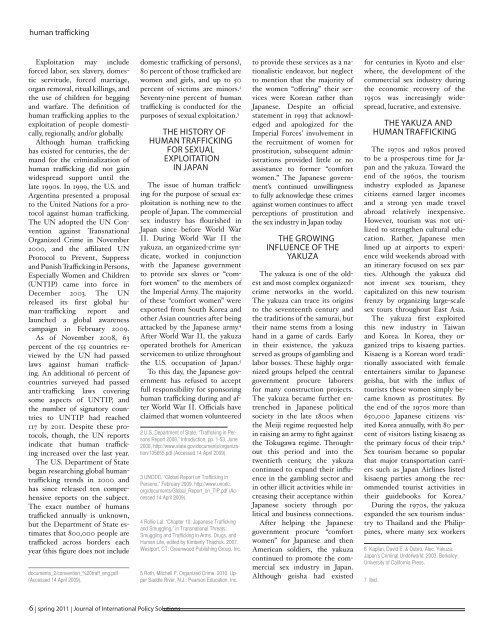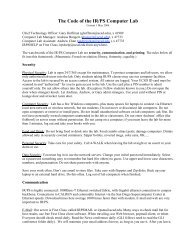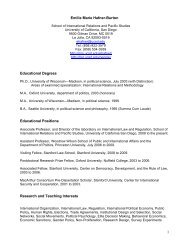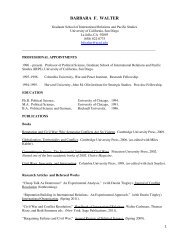to download the full journal. (1.2MB PDF) - School of International ...
to download the full journal. (1.2MB PDF) - School of International ...
to download the full journal. (1.2MB PDF) - School of International ...
Create successful ePaper yourself
Turn your PDF publications into a flip-book with our unique Google optimized e-Paper software.
human trafficking<br />
Exploitation may include<br />
forced labor, sex slavery, domestic<br />
servitude, forced marriage,<br />
organ removal, ritual killings, and<br />
<strong>the</strong> use <strong>of</strong> children for begging<br />
and warfare. The definition <strong>of</strong><br />
human trafficking applies <strong>to</strong> <strong>the</strong><br />
exploitation <strong>of</strong> people domestically,<br />
regionally, and/or globally.<br />
Although human trafficking<br />
has existed for centuries, <strong>the</strong> demand<br />
for <strong>the</strong> criminalization <strong>of</strong><br />
human trafficking did not gain<br />
widespread support until <strong>the</strong><br />
late 1990s. In 1999, <strong>the</strong> U.S. and<br />
Argentina presented a proposal<br />
<strong>to</strong> <strong>the</strong> United Nations for a pro<strong>to</strong>col<br />
against human trafficking.<br />
The UN adopted <strong>the</strong> UN Convention<br />
against Transnational<br />
Organized Crime in November<br />
2000, and <strong>the</strong> affiliated UN<br />
Pro<strong>to</strong>col <strong>to</strong> Prevent, Suppress<br />
and Punish Trafficking in Persons,<br />
Especially Women and Children<br />
(UNTIP) came in<strong>to</strong> force in<br />
December 2003. The UN<br />
released its first global human-trafficking<br />
report and<br />
launched a global awareness<br />
campaign in February 2009.<br />
As <strong>of</strong> November 2008, 63<br />
percent <strong>of</strong> <strong>the</strong> 155 countries reviewed<br />
by <strong>the</strong> UN had passed<br />
laws against human trafficking.<br />
An additional 16 percent <strong>of</strong><br />
countries surveyed had passed<br />
anti-trafficking laws covering<br />
some aspects <strong>of</strong> UNTIP, and<br />
<strong>the</strong> number <strong>of</strong> signa<strong>to</strong>ry countries<br />
<strong>to</strong> UNTIP had reached<br />
117 by 2011. Despite <strong>the</strong>se pro<strong>to</strong>cols,<br />
though, <strong>the</strong> UN reports<br />
indicate that human trafficking<br />
increased over <strong>the</strong> last year.<br />
The U.S. Department <strong>of</strong> State<br />
began researching global humantrafficking<br />
trends in 2000 and<br />
has since released ten comprehensive<br />
reports on <strong>the</strong> subject.<br />
The exact number <strong>of</strong> humans<br />
trafficked annually is unknown,<br />
but <strong>the</strong> Department <strong>of</strong> State estimates<br />
that 800,000 people are<br />
trafficked across borders each<br />
year (this figure does not include<br />
documents_2/convention_%20traff_eng.pdf<br />
(Accessed 14 April 2009).<br />
domestic trafficking <strong>of</strong> persons),<br />
80 percent <strong>of</strong> those trafficked are<br />
women and girls, and up <strong>to</strong> 50<br />
percent <strong>of</strong> victims are minors. 2<br />
Seventy-nine percent <strong>of</strong> human<br />
trafficking is conducted for <strong>the</strong><br />
purposes <strong>of</strong> sexual exploitation. 3<br />
THE HISTORY OF<br />
HUMAN TRAFFICKING<br />
FOR SEXUAL<br />
EXPLOITATION<br />
IN JAPAN<br />
The issue <strong>of</strong> human trafficking<br />
for <strong>the</strong> purpose <strong>of</strong> sexual exploitation<br />
is nothing new <strong>to</strong> <strong>the</strong><br />
people <strong>of</strong> Japan. The commercial<br />
sex industry has flourished in<br />
Japan since before World War<br />
II. During World War II <strong>the</strong><br />
yakuza, an organized-crime syndicate,<br />
worked in conjunction<br />
with <strong>the</strong> Japanese government<br />
<strong>to</strong> provide sex slaves or “comfort<br />
women” <strong>to</strong> <strong>the</strong> members <strong>of</strong><br />
<strong>the</strong> Imperial Army. The majority<br />
<strong>of</strong> <strong>the</strong>se “comfort women” were<br />
exported from South Korea and<br />
o<strong>the</strong>r Asian countries after being<br />
attacked by <strong>the</strong> Japanese army. 4<br />
After World War II, <strong>the</strong> yakuza<br />
operated bro<strong>the</strong>ls for American<br />
servicemen <strong>to</strong> utilize throughout<br />
<strong>the</strong> U.S. occupation <strong>of</strong> Japan. 5<br />
To this day, <strong>the</strong> Japanese government<br />
has refused <strong>to</strong> accept<br />
<strong>full</strong> responsibility for sponsoring<br />
human trafficking during and after<br />
World War II. Officials have<br />
claimed that women volunteered<br />
2 U.S. Department <strong>of</strong> State, “Trafficking in Persons<br />
Report 2008,” Introduction, pp. 1-53, June<br />
2008, http://www.state.gov/documents/organization/105655.pdf<br />
(Accessed 14 April 2009).<br />
3 UNODC, “Global Report on Trafficking in<br />
Persons,” February 2009, http://www.unodc.<br />
org/documents/Global_Report_on_TIP.pdf (Accessed<br />
14 April 2009).<br />
4 Rollie Lal, “Chapter 10: Japanese Trafficking<br />
and Smuggling,” in Transnational Threats:<br />
Smuggling and Trafficking in Arms, Drugs, and<br />
Human Life, edited by Kimberly Thachuk. 2007.<br />
Westport, CT: Greenwood Publishing Group, Inc.<br />
5 Roth, Mitchell P. Organized Crime. 2010. Upper<br />
Saddle River, N.J.: Pearson Education, Inc.<br />
<strong>to</strong> provide <strong>the</strong>se services as a nationalistic<br />
endeavor, but neglect<br />
<strong>to</strong> mention that <strong>the</strong> majority <strong>of</strong><br />
<strong>the</strong> women “<strong>of</strong>fering” <strong>the</strong>ir services<br />
were Korean ra<strong>the</strong>r than<br />
Japanese. Despite an <strong>of</strong>ficial<br />
statement in 1993 that acknowledged<br />
and apologized for <strong>the</strong><br />
Imperial Forces’ involvement in<br />
<strong>the</strong> recruitment <strong>of</strong> women for<br />
prostitution, subsequent administrations<br />
provided little or no<br />
assistance <strong>to</strong> former “comfort<br />
women.” The Japanese government’s<br />
continued unwillingness<br />
<strong>to</strong> <strong>full</strong>y acknowledge <strong>the</strong>se crimes<br />
against women continues <strong>to</strong> affect<br />
perceptions <strong>of</strong> prostitution and<br />
<strong>the</strong> sex industry in Japan <strong>to</strong>day.<br />
THE GROWING<br />
INFLUENCE OF THE<br />
YAKUZA<br />
The yakuza is one <strong>of</strong> <strong>the</strong> oldest<br />
and most complex organizedcrime<br />
networks in <strong>the</strong> world.<br />
The yakuza can trace its origins<br />
<strong>to</strong> <strong>the</strong> seventeenth century and<br />
<strong>the</strong> traditions <strong>of</strong> <strong>the</strong> samurai, but<br />
<strong>the</strong>ir name stems from a losing<br />
hand in a game <strong>of</strong> cards. Early<br />
in <strong>the</strong>ir existence, <strong>the</strong> yakuza<br />
served as groups <strong>of</strong> gambling and<br />
labor bosses. These highly organized<br />
groups helped <strong>the</strong> central<br />
government procure laborers<br />
for many construction projects.<br />
The yakuza became fur<strong>the</strong>r entrenched<br />
in Japanese political<br />
society in <strong>the</strong> late 1800s when<br />
<strong>the</strong> Meiji regime requested help<br />
in raising an army <strong>to</strong> fight against<br />
<strong>the</strong> Tokugawa regime. Throughout<br />
this period and in<strong>to</strong> <strong>the</strong><br />
twentieth century, <strong>the</strong> yakuza<br />
continued <strong>to</strong> expand <strong>the</strong>ir influence<br />
in <strong>the</strong> gambling sec<strong>to</strong>r and<br />
in o<strong>the</strong>r illicit activities while increasing<br />
<strong>the</strong>ir acceptance within<br />
Japanese society through political<br />
and business connections.<br />
After helping <strong>the</strong> Japanese<br />
government procure “comfort<br />
women” for Japanese and <strong>the</strong>n<br />
American soldiers, <strong>the</strong> yakuza<br />
continued <strong>to</strong> promote <strong>the</strong> commercial<br />
sex industry in Japan.<br />
Although geisha had existed<br />
for centuries in Kyo<strong>to</strong> and elsewhere,<br />
<strong>the</strong> development <strong>of</strong> <strong>the</strong><br />
commercial sex industry during<br />
<strong>the</strong> economic recovery <strong>of</strong> <strong>the</strong><br />
1950s was increasingly widespread,<br />
lucrative, and extensive.<br />
THE YAKUZA AND<br />
HUMAN TRAFFICKING<br />
The 1970s and 1980s proved<br />
<strong>to</strong> be a prosperous time for Japan<br />
and <strong>the</strong> yakuza. Toward <strong>the</strong><br />
end <strong>of</strong> <strong>the</strong> 1960s, <strong>the</strong> <strong>to</strong>urism<br />
industry exploded as Japanese<br />
citizens earned larger incomes<br />
and a strong yen made travel<br />
abroad relatively inexpensive.<br />
However, <strong>to</strong>urism was not utilized<br />
<strong>to</strong> streng<strong>the</strong>n cultural education.<br />
Ra<strong>the</strong>r, Japanese men<br />
lined up at airports <strong>to</strong> experience<br />
wild weekends abroad with<br />
an itinerary focused on sex parties.<br />
Although <strong>the</strong> yakuza did<br />
not invent sex <strong>to</strong>urism, <strong>the</strong>y<br />
capitalized on this new <strong>to</strong>urism<br />
frenzy by organizing large-scale<br />
sex <strong>to</strong>urs throughout East Asia.<br />
The yakuza first exploited<br />
this new industry in Taiwan<br />
and Korea. In Korea, <strong>the</strong>y organized<br />
trips <strong>to</strong> kisaeng parties.<br />
Kisaeng is a Korean word traditionally<br />
associated with female<br />
entertainers similar <strong>to</strong> Japanese<br />
geisha, but with <strong>the</strong> influx <strong>of</strong><br />
<strong>to</strong>urists <strong>the</strong>se women simply became<br />
known as prostitutes. By<br />
<strong>the</strong> end <strong>of</strong> <strong>the</strong> 1970s more than<br />
650,000 Japanese citizens visited<br />
Korea annually, with 80 percent<br />
<strong>of</strong> visi<strong>to</strong>rs listing kisaeng as<br />
<strong>the</strong> primary focus <strong>of</strong> <strong>the</strong>ir trip. 6<br />
Sex <strong>to</strong>urism became so popular<br />
that major transportation carriers<br />
such as Japan Airlines listed<br />
kisaeng parties among <strong>the</strong> recommended<br />
<strong>to</strong>urist activities in<br />
<strong>the</strong>ir guidebooks for Korea. 7<br />
During <strong>the</strong> 1970s, <strong>the</strong> yakuza<br />
expanded <strong>the</strong> sex <strong>to</strong>urism industry<br />
<strong>to</strong> Thailand and <strong>the</strong> Philippines,<br />
where many sex workers<br />
6 Kaplan, David E. & Dubro, Alec. Yakuza:<br />
Japan’s Criminal Underworld. 2003. Berkeley:<br />
University <strong>of</strong> California Press.<br />
7 Ibid.<br />
6 | spring 2011 | Journal <strong>of</strong> <strong>International</strong> Policy Solutions






